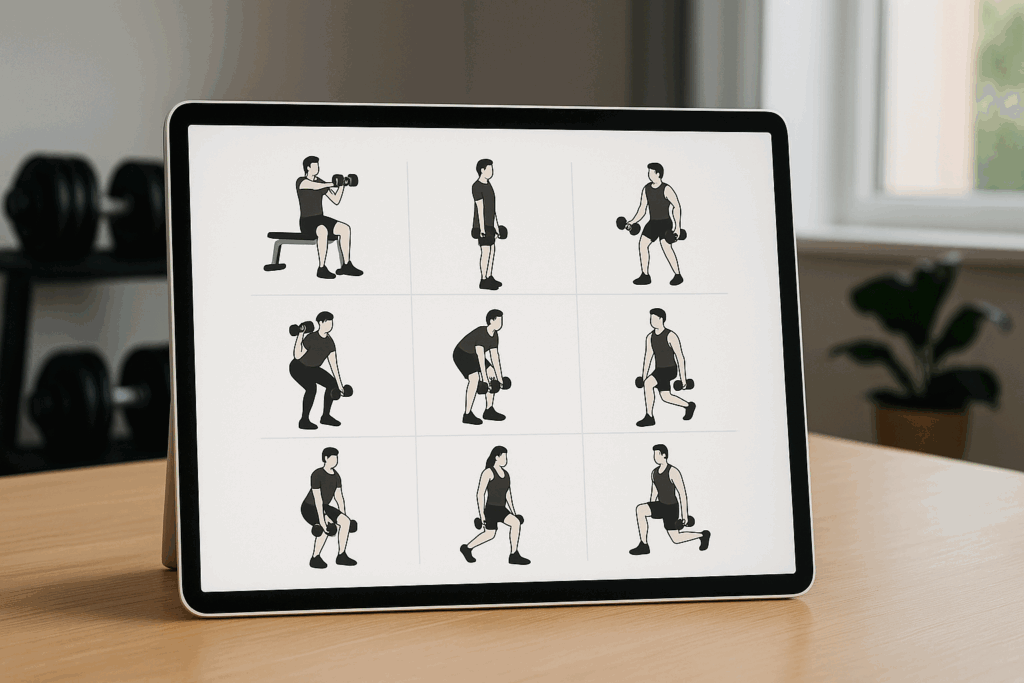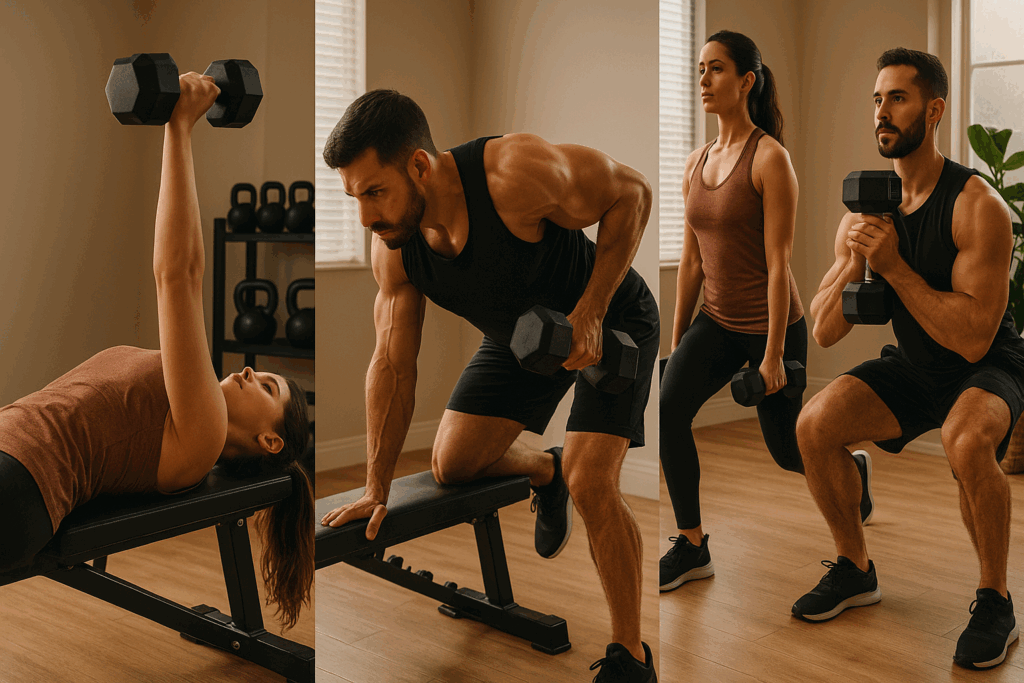Achieving full-body strength doesn’t require daily hours in a commercial gym or access to specialized equipment. In fact, many individuals seeking efficient, sustainable routines are turning to simpler, more structured approaches that prioritize consistency, progressive overload, and intelligent movement patterns. A particularly effective method for building balanced strength and muscle across the entire body is the 3 day a week dumbbell workout. Designed with flexibility, science, and longevity in mind, this training strategy empowers individuals of varying experience levels to make measurable progress while maintaining harmony with their professional and personal schedules.
You may also like: The Ultimate Beginner Gym Split for Fast, Effective Results
The appeal of the 3 day a week dumbbell workout lies in its elegant simplicity. Rather than cramming excessive volume into daily routines or splitting training across multiple body parts each week, this approach maximizes efficiency and recovery through three intelligently programmed sessions. The use of dumbbells adds a functional, joint-friendly dimension to the regimen, allowing for greater range of motion, unilateral emphasis, and versatility. Whether your goal is hypertrophy, strength, endurance, or fat loss, this model provides the structure necessary to reach it—without burnout or monotony.
Why Choose a 3 Day Dumbbell Workout?
Many fitness enthusiasts find themselves overwhelmed by the abundance of training philosophies, each promising unparalleled results. The 3 day dumbbell workout stands out because it respects the physiological needs of the body while accommodating the practical constraints of everyday life. Three training sessions per week provide sufficient frequency to stimulate muscular adaptation, while allowing ample recovery for muscle repair, central nervous system recuperation, and mental reset.
For beginners, the three day dumbbell workout represents an accessible entry point to resistance training. It avoids the complexity and potential intimidation of six-day bro-splits, while still offering a comprehensive stimulus. For advanced athletes, it becomes an opportunity to refocus on quality over quantity—intensity, control, and progression replace mere volume as drivers of success. Moreover, dumbbells facilitate safer exploration of ranges of motion, allow for subtle asymmetry correction, and reduce reliance on fixed machines that may limit individual biomechanics.

Structuring Your 3 Day a Week Dumbbell Workout for Maximum Benefit
To build an effective 3 day a week dumbbell workout, you must first establish a clear structure that promotes balance, overload, and progression. A well-rounded weekly template may follow one of several configurations: full-body workouts each day, or an upper-lower-full split that targets different muscle groups on different days. Each approach has merit depending on the individual’s goals, schedule, and recovery capacity.
In a full-body format, each session includes one or two compound lifts that stimulate multiple muscle groups, followed by accessory movements that hone in on specific areas. This setup provides regular frequency per muscle group, essential for both hypertrophy and neuromuscular adaptation. Alternatively, the upper-lower-full split allows for increased volume and intensity per body region per session, while still ensuring every muscle group is trained at least twice per week.
Volume and intensity must be carefully calibrated. For hypertrophy, most exercises should fall within the 8–12 rep range, utilizing loads that reach technical failure within that range. Strength-focused sessions may use lower reps with heavier weights and longer rest periods. Regardless of goal, consistency and gradual overload—either by increasing weight, reps, or reducing rest—are non-negotiable elements of long-term success.

The Science Behind Dumbbell Training for Strength
Dumbbell-based training, though sometimes perceived as less effective than barbell or machine work, offers unique physiological advantages when employed thoughtfully. Research highlights that dumbbells activate more stabilizer muscles than machines due to the necessity of unilateral control and balance. This leads to improved proprioception, joint integrity, and real-world strength that translates into daily function and athletic performance.
Unlike barbells, which lock the limbs into fixed paths, dumbbells allow each arm to move independently, accommodating anatomical differences and reducing injury risk. They are especially advantageous for correcting imbalances between dominant and non-dominant sides. Furthermore, dumbbell pressing movements, such as the flat or incline dumbbell bench press, activate more of the stabilizing musculature around the shoulder girdle than barbell equivalents.
Progressive overload remains the guiding principle. By gradually increasing resistance, manipulating tempo, or intensifying time under tension, lifters can stimulate continuous adaptation. Training three times a week allows each session to deliver focused effort without compromising recovery—essential for long-term strength development.

3 Day a Week Dumbbell Workout for Full-Body Strength: Day-by-Day Breakdown
To demonstrate how a 3 day a week dumbbell workout might be organized for full-body strength, let us consider a sample framework that blends compound lifts, accessory work, and metabolic conditioning across three weekly sessions. The plan below assumes access to a standard set of dumbbells and a bench.
Day 1: Push Focus (Chest, Shoulders, Triceps)
This session emphasizes horizontal and vertical pressing. Start with the dumbbell flat bench press, a foundational movement for building pectoral and triceps strength. Follow with standing overhead dumbbell presses to recruit the anterior deltoids and upper traps. Accessories such as lateral raises and triceps extensions refine muscular development and balance the pressing volume.
Day 2: Pull Focus (Back, Biceps)
Begin with a dumbbell Romanian deadlift, targeting the posterior chain and establishing a powerful hip hinge pattern. One-arm dumbbell rows build unilateral strength and core stability, while dumbbell curls and hammer curls enhance arm aesthetics and grip strength. Rear delt flyes or reverse rows support scapular stability and postural integrity.
Day 3: Lower Body + Core
This day centers on lower-body strength and foundational core training. Dumbbell goblet squats develop quads, glutes, and adductors, while Bulgarian split squats provide intense unilateral leg training. Dumbbell swings, inspired by kettlebell movements, offer dynamic posterior-chain activation and conditioning. Conclude with weighted planks or dumbbell Russian twists to challenge core endurance and rotational stability.
Each session should be preceded by a dynamic warm-up and concluded with static stretching or mobility work. Adjust sets, reps, and rest intervals based on training objectives and individual capacity.

Adaptability and Progression in the Three Day Dumbbell Workout Model
The enduring strength of the three day dumbbell workout model lies in its adaptability. It welcomes modifications for age, injury history, equipment availability, and evolving fitness goals. For older adults or those recovering from injury, movements can be simplified and intensity reduced while maintaining functional benefits. For athletes or advanced lifters, intensity techniques such as drop sets, supersets, and pauses can amplify workload without additional volume.
Progression should be tracked meticulously. A logbook or digital tracker ensures that performance metrics are visible and goals remain tangible. Each week should aim for incremental improvement in either resistance used, repetitions completed, or time under tension. Deload weeks may be implemented every four to six weeks to facilitate recovery and prevent overtraining.
This model also accommodates hybrid goals. For instance, those pursuing both fat loss and strength can incorporate high-intensity interval training (HIIT) or circuit-style sessions into the three weekly workouts, preserving muscle mass while elevating caloric expenditure.

Nutrition and Recovery Considerations for Dumbbell Training
No training program can reach its full potential without adequate nutritional and recovery support. For those engaging in a 3 day a week dumbbell workout, dietary intake must reflect training intensity, desired outcomes, and overall lifestyle. Those seeking muscle gain must maintain a caloric surplus with emphasis on protein intake, ideally consuming 1.6 to 2.2 grams of protein per kilogram of bodyweight daily.
Conversely, individuals focused on fat loss should establish a slight caloric deficit, ensuring that protein remains high to preserve lean mass. Carbohydrates should be centered around training days to support performance and recovery. Fats, though essential, should not dominate the diet in ways that compromise hormonal balance or energy availability.
Recovery extends beyond nutrition. Sleep is the cornerstone of muscular repair, cognitive clarity, and hormonal regulation. Adults should aim for seven to nine hours of uninterrupted sleep nightly. In addition, active recovery practices such as light aerobic movement, stretching, and foam rolling contribute to tissue quality and mobility, reducing the risk of chronic stiffness or overuse injuries.
Common Mistakes to Avoid in a 3 Day Dumbbell Workout Routine
Despite its simplicity, there are several pitfalls that can hinder progress in a 3 day dumbbell workout regimen. One common mistake is neglecting progressive overload. Without systematic increases in intensity or complexity, the body adapts to stimulus and progress plateaus. Another error is sacrificing form for weight. Proper biomechanics should always precede ego-driven loading, particularly in free-weight training where stabilizer muscle recruitment is high.
Program hopping is another obstacle. Many exercisers abandon routines prematurely, chasing novelty rather than results. A three day dumbbell workout plan requires commitment across at least eight to twelve weeks before meaningful progress can be evaluated. Additionally, many individuals fail to address imbalances, either by overemphasizing pushing over pulling or ignoring unilateral weaknesses. Including a mix of bilateral and unilateral movements, pushing and pulling, horizontal and vertical planes ensures muscular symmetry and injury resilience.
Lastly, recovery is often underestimated. Overzealous training without appropriate rest, nutrition, and stress management not only diminishes returns but increases the likelihood of injury. The beauty of a 3 day format lies in its built-in recovery windows, which must be used intelligently for optimal results.
Lifestyle Integration: Making the 3 Day Dumbbell Workout Sustainable
For any training protocol to be successful, it must integrate seamlessly into one’s lifestyle. The 3 day a week dumbbell workout model excels in this regard. Its low time commitment means it can be sustained even amidst demanding schedules, travel, or shifting priorities. Whether performed in a home gym, commercial facility, or outdoor space, the versatility of dumbbell workouts ensures accessibility without logistical hurdles.
Consistency is key. Scheduling workouts on the same days each week creates habitual behavior. Pairing sessions with existing routines—such as training before work, during lunch breaks, or immediately after school pick-up—helps anchor the habit. Social accountability through training partners or virtual communities also fosters adherence.
Beyond the physical, the mental benefits of structured resistance training cannot be overstated. A regular three day dumbbell workout offers a controlled environment for stress relief, self-mastery, and confidence building. Each rep becomes a vote for identity transformation, reinforcing self-discipline and resilience across domains.

Tracking Progress and Evaluating Outcomes
Objective tracking is essential for assessing the effectiveness of a training protocol. In the case of a 3 day a week dumbbell workout, progress can be monitored through various metrics: strength improvements in key lifts, changes in body composition, enhancements in mobility, or even psychological markers such as mood stability and self-esteem.
Photographic documentation and circumference measurements can supplement scale weight to provide a fuller picture of physique evolution. Functional tests, such as the ability to perform a certain number of push presses with a given load or sustain a plank for an extended duration, also offer valuable feedback.
Subjective experiences matter as well. Are workouts leaving you energized or depleted? Do joints feel stable and strong, or sore and overworked? Are you maintaining consistency without emotional fatigue? These qualitative indicators, when interpreted alongside objective data, guide the refinement of programming to ensure it continues serving your evolving needs.
Expanding Your Training: When and How to Add Complexity
Over time, your needs and goals may evolve. While the 3 day dumbbell workout framework is robust and adaptable, there may come a point when increased stimulus is necessary. This does not mean abandoning the model entirely; rather, it invites intelligent layering of complexity.
Progression may take the form of movement variation (e.g., adding tempo or instability), equipment diversification (e.g., incorporating resistance bands or kettlebells), or split restructuring (e.g., shifting to an upper/lower/conditioning rotation). Frequency may increase to four or five days per week, provided recovery capacity supports it.
The key is intentionality. Every adjustment must serve a defined goal and be evaluated for efficacy. Periodic program audits—evaluating outcomes every 8–12 weeks—help prevent stagnation and ensure alignment with broader health and performance aspirations.
The Psychological Value of Simplicity and Mastery
In an age of algorithm-driven hyperstimulation, the psychological benefits of simplicity and mastery cannot be understated. The 3 day dumbbell workout strips away the clutter of over-engineered routines and reorients the focus toward execution, intention, and mastery of fundamentals. This minimalist architecture fosters deeper engagement, greater self-awareness, and increased ownership over one’s progress.
By cycling through the same movement patterns and refining technique, practitioners develop kinesthetic intelligence and bodily trust. Each session becomes a meditative ritual as much as a physical endeavor. In a cultural context where burnout, information overload, and decision fatigue are rampant, the clarity of a well-structured three day dumbbell workout plan becomes a source of grounding and empowerment.
Frequently Asked Questions: Expert Insights into the 3 Day a Week Dumbbell Workout
How can I tailor a 3 day a week dumbbell workout for athletic performance?
Athletes can modify the 3 day a week dumbbell workout by emphasizing movement patterns that transfer to their sport, such as rotational core exercises, single-leg stability work, and explosive push-pull patterns. Including elements like jump squats, renegade rows, and rotational presses can mimic real-game demands while maintaining a strength foundation. Incorporating reactive or tempo-based sets—such as performing reps with a pause or with rapid concentric intent—can sharpen neuromuscular responsiveness. Recovery between sessions should be monitored closely since athletes often have additional practice loads. This workout structure can be used during in-season maintenance or off-season foundational training, offering a scalable solution to performance needs.
What’s the best way to measure progress during a 3 day dumbbell workout routine?
Progress within a 3 day dumbbell workout is best tracked using a combination of objective and subjective markers. Objective indicators include tracking the weight lifted, total volume (sets x reps x weight), and improvements in time under tension or form consistency. Subjectively, noticing increased energy post-workout, fewer joint aches, and greater confidence in movement patterns can also signify improvement. Consider also using performance benchmarks, such as completing a set number of goblet squats within a time frame or increasing your one-arm row weight over weeks. Using a training journal or a workout app ensures consistency and accountability while making it easier to identify plateaus or regression.
Can I combine cardio with a 3 day a week dumbbell workout without losing muscle?
Yes, cardio can complement a 3 day a week dumbbell workout if programmed wisely. Low-impact cardio sessions, such as brisk walking, swimming, or cycling, on non-lifting days support cardiovascular health and recovery without depleting muscle tissue. High-intensity interval training (HIIT) can be used sparingly, ideally on the same day as lifting to consolidate stress and allow full recovery days. To preserve muscle mass, ensure adequate protein intake and avoid performing intense cardio right before strength sessions. Monitor your body composition and performance metrics to fine-tune the balance between fat loss and muscle maintenance.
How does a three day dumbbell workout compare to a traditional 5-day split?
A three day dumbbell workout often provides a more balanced approach for individuals managing multiple responsibilities. While a 5-day split allows for greater training volume per muscle group, it can be taxing on recovery and difficult to sustain long-term. The three-day approach emphasizes full-body or push-pull-lower splits, which improve muscle frequency and functional strength while allowing rest between sessions. For those not pursuing competitive bodybuilding, the three day format is more adaptable and often leads to better consistency and fewer missed sessions. Additionally, a three day dumbbell workout requires less planning and equipment, making it accessible for home training setups.
What are some common signs that I should deload during a 3 day dumbbell workout program?
Even a well-structured 3 day dumbbell workout may require periodic deloading. Signs include persistent fatigue, declining performance despite consistent effort, sleep disruption, elevated resting heart rate, or nagging joint pain. Psychological markers such as irritability or lack of motivation to train can also indicate central nervous system fatigue. A deload week doesn’t mean stopping entirely; it may involve reducing weight loads, sets, or intensity while focusing on mobility and technique refinement. Implementing scheduled deloads every 4–6 weeks can prevent burnout and keep long-term progress sustainable.
3 Day a Week Dumbbell Workout for Busy Professionals: Is It Enough?
Absolutely. For professionals juggling meetings, family, and commutes, a 3 day a week dumbbell workout offers a realistic path to health without disrupting life balance. The key is maximizing each session’s efficiency by focusing on compound lifts, minimal rest, and consistent progression. Over time, the cumulative effect of consistent three-day workouts leads to improved posture, strength, energy levels, and metabolic health. Many professionals find that fewer sessions increase their long-term adherence compared to sporadic five-day plans. This model respects both time and recovery, which are often in short supply in high-stress careers.
How can women benefit uniquely from a three day dumbbell workout approach?
Women often benefit from dumbbell-based routines due to the versatility and comfort dumbbells provide over fixed machines or intimidating barbells. A three day dumbbell workout encourages total-body strengthening, which is critical for joint support, hormone regulation, and metabolic resilience. This format also promotes muscle retention during phases of fat loss without inducing the stress of overtraining. Furthermore, emphasizing unilateral work like split squats and single-arm rows helps develop balanced strength and reduce injury risks, particularly around the hips and shoulders. The consistency of three sessions weekly fosters empowerment, body confidence, and long-term habit formation.
What equipment upgrades can enhance a 3 day dumbbell workout at home?
While dumbbells form the foundation, simple additions can expand the range and intensity of your sessions. Adjustable dumbbells save space while allowing progression. A flat or adjustable bench opens options for presses and split squats. Resistance bands add accommodating resistance and make warmups or finishers more dynamic. A stability ball or foam pad can introduce balance elements that challenge the core and stabilizers further. Investing gradually in high-value gear can keep a 3 day dumbbell workout fresh and progressive without requiring a full home gym.
Should older adults follow a modified 3 day dumbbell workout structure?
Yes, and it can be particularly beneficial. Older adults often experience joint stiffness, muscle atrophy, and balance issues—all of which can be addressed with a tailored 3 day dumbbell workout. Focus should be on slow, controlled reps, joint-friendly ranges of motion, and movements that improve stability, such as step-ups and suitcase carries. Load should remain moderate, but progression must still be applied over time to maintain neuromuscular efficiency. Paired with mobility work and adequate recovery, this approach supports autonomy, bone density, and cognitive health in aging populations.
What long-term results can I realistically expect from a 3 day a week dumbbell workout?
Over the span of 6–12 months, a 3 day a week dumbbell workout can yield profound changes in both physique and performance. Expect increases in total-body strength, better posture, reduced risk of injury, and enhanced muscular tone. Mental benefits, including improved focus, stress reduction, and greater self-confidence, also emerge as training becomes habitual. Consistency is the primary driver—those who stay committed often surpass initial expectations due to cumulative adaptation. When combined with intelligent nutrition, sleep, and lifestyle choices, the three day model becomes a long-term solution rather than a short-term fix.
Conclusion: Building Resilient Strength with a 3 Day a Week Dumbbell Workout
Sustainable fitness is built on clarity, consistency, and smart programming—all of which are exemplified in the 3 day a week dumbbell workout model. By training with intention three times per week, individuals can achieve remarkable improvements in full-body strength, muscular balance, and functional capacity. The program’s adaptability allows it to meet you where you are, while its progressive structure ensures that you continue moving forward.
Whether you are a busy professional, a stay-at-home parent, a traveling entrepreneur, or an athlete managing recovery, this method offers an elegant solution to a universal challenge: how to train effectively within the constraints of real life. With a pair of dumbbells and a plan built on evidence-based principles, you can unlock transformative results without sacrificing your time, energy, or enthusiasm.
Ultimately, the greatest gift of the three day dumbbell workout is not merely the strength it builds, but the confidence, resilience, and clarity it cultivates along the way. Through deliberate practice, mindful effort, and a commitment to your own evolution, this training strategy becomes more than exercise—it becomes a practice in living strong.
Further Reading:
Dumbbell Only Workout: 3 Day Full Body Dumbbell Workout
Three Day Dumbbell Workout Plan For Size, Strength and Fitness
Build Size and Strength in 30 Minutes with This 3-Day Workout Dumbbell Plan





